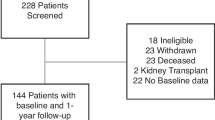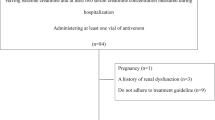Abstract
Background
Pediatric acute kidney injury (AKI) is associated with long-term morbidity and mortality; however, outcomes improve when AKI is detected earlier. Current definitions of AKI use baseline creatinine; community-acquired AKI (CA-AKI) is difficult to define and detect in the pediatric emergency department (ED) when no baseline creatinine is available. Our objective was to compare age- and gender-based creatinine norms to the traditional baseline (lowest creatinine in previous 3 months) to diagnose CA-AKI.
Methods
This was a retrospective cross-sectional study conducted in children 1 month–18 years of age seen in the pediatric ED in whom a creatinine was obtained.
Results
Per the Kidney Disease Improving Global Outcomes AKI definition in encounters with baseline creatinine available, 343/2338 (14.7%) had CA-AKI. When the upper limit of the age- and gender-based creatinine norm was applied as a surrogate baseline creatinine, CA-AKI was diagnosed in 1.5% of encounters (239/15,486). Additionally, CA-AKI was diagnosed in 178 cases using the upper limit of age- and gender-based creatinine norms only, as these cases did not have a baseline creatinine.
Conclusions
Age- and gender-based creatinine norms can be applied as a surrogate baseline to detect CA-AKI in all children regardless of whether baseline creatinine is available, potentially detecting it earlier.
Similar content being viewed by others
Log in or create a free account to read this content
Gain free access to this article, as well as selected content from this journal and more on nature.com
or
References
Alkandari, O. et al. Acute kidney injury is an independent risk factor for pediatric intensive care unit mortality, longer length of stay and prolonged mechanical ventilation in critically ill children: a two-center retrospective cohort study. Crit. Care 15, R146 (2011).
Kaddourah, A. et al. Epidemiology of acute kidney injury in critically ill children and young adults. N. Engl. J. Med. 376, 11–20 (2017).
Hessey, E. et al. Long-term mortality after acute kidney injury in the pediatric ICU. Hosp. Pediatr. 8, 260–268 (2018).
Holmes, J. et al. The incidence of pediatric acute kidney injury is increased when identified by a change in a creatinine-based electronic alert. Kidney Int. 92, 432–439 (2017).
Hsu, C. N., Chen, H. L. & Tain, Y. L. Epidemiology and outcomes of community-acquired and hospital-acquired acute kidney injury in children and adolescents. Pediatr. Res. 83, 622–629 (2018).
Bernardo, E. O. et al. Community-acquired acute kidney injury among children seen in the pediatric emergency department. Acad. Emerg. Med. 25, 758–768 (2018).
Obichukwu, C. C. et al. Community-acquired acute kidney injury in critically ill children as seen in the emergency unit of a tertiary hospital in Enugu, Southeast Nigeria. Niger. J. Clin. Pract. 20, 746–753 (2017).
Evans, R. D. et al. Incidence, etiology, and outcomes of community-acquired acute kidney injury in pediatric admissions in Milawi. Perit. Dial. Int. 38, 405–412 (2018).
Soares, D. M. et al. Delayed nephrology consultation and high mortality on acute kidney injury: a meta-analysis. Blood Purif. 43, 57–67 (2017).
DeRosa, S., Samoni, S. & Ronco, C. Creatinine-based definitions: from baseline creatinine to serum creatinine adjustment in Intensive care. Crit. Care 20, 69 (2016).
Akcan Arikan, A. et al. Resuscitation bundle in pediatric shock decreases acute kidney injury and improves outcomes. J. Pediatr. 167, 1301–1305 (2015).
Sutherland, S. M. et al. AKI in hospitalized children: Comparing the pRIFLE, AKIN, and KDIGO definitions. Clin. J. Am. Soc. Nephrol. 10, 554–561 (2015).
Hessey, E. et al. Evaluation of height-dependent and height-independent methods of estimating baseline serum creatinine in critically ill children. Pediatr. Nephrol. 32, 1953–1962 (2017).
Hoste, L. et al. A new equation to estimate the glomerular filtration rate in children, adolescents and young adults. Nephrol. Dial. Transplant. 29, 1082–1091 (2014).
Zappitelli, M. et al. Ascertainment and epidemiology of acute kidney injury varies with definition interpretation. Clin. J. Am. Soc. Nephrol. 3, 948–954 (2008).
KDIGO AKI Work Group. KDIGO clinical practice guideline for acute kidney injury. Kidney Int. Suppl. 2, 1–138 (2012).
Moffett, B. S. & Goldstein, S. L. Acute kidney injury and increasing nephrotoxic-medication exposure in noncritically-ill children. Clin. J. Am. Soc. Nephrol. 6, 856–863 (2011).
Li, N. et al. Ceftriaxone and acute renal failure in children. Pediatrics 133, e917–e922 (2014).
Colantonio, D. A. et al. Closing the gaps in pediatric laboratory reference intervals: a CALIPER database of 40 biochemical markers in a healthy and multi-ethnic population of children. Clin. Chem. 58, 854–868 (2012).
Zapatelli, M., Zhang, X. & Foster, B. J. Estimating glomerular filtration rate in children at serial follow-up when height is unknown. Clin. J. Am. Soc. Nephrol. 5, 1763–1769 (2010).
Blufpand, H. N. et al. Height-independent estimation of glomerular filtration rate in children: an alternative to the Schwartz equation. J. Pediatr. 163, 1722–1727 (2013).
Author information
Authors and Affiliations
Contributions
E.R.O. designed the study, collected, reviewed, and analyzed data, performed statistical analysis, crafted the manuscript, and critically revised the manuscript. A.T.C. designed the study, performed statistical analysis, and critically revised the manuscript. G.J.B. designed the study, collected, reviewed and analyzed data, and revised the manuscript. L.M. and H.E.S. collected, reviewed and analyzed data, and revised the manuscript. S.D. designed the study and revised the manuscript. L.L.L. designed the study and critically revised the manuscript. A.A.A. designed the study, reviewed and analyzed data, performed statistical analysis, and critically revised the manuscript.
Corresponding author
Ethics declarations
Competing interests
A.A.A. has consulted for Baxter and receives research funding from NIAID. The other authors declare no competing interests.
Additional information
Publisher’s note Springer Nature remains neutral with regard to jurisdictional claims in published maps and institutional affiliations.
Rights and permissions
About this article
Cite this article
O’Neil, E.R., Devaraj, S., Mayorquin, L. et al. Defining pediatric community-acquired acute kidney injury: an observational study. Pediatr Res 87, 564–568 (2020). https://doi.org/10.1038/s41390-019-0577-3
Received:
Revised:
Accepted:
Published:
Issue date:
DOI: https://doi.org/10.1038/s41390-019-0577-3
This article is cited by
-
Sepsis criteria and kidney function: eliminating sex, age and economic status biases
Nature Reviews Nephrology (2025)



